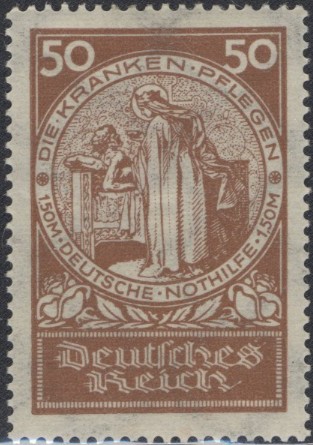
Deutschland - Allemagne
Return To Catalogue - Germany Overview - Germany 1921-1923 inflation period, part 2 - Stamps issued after 1936
Note: on my website many of the
pictures can not be seen! They are of course present in the cd's;
contact me if you want to purchase them: evert@klaseboer.com.
Germany 1921-1923 inflation period
5 p green ('DIE HUNGRIGEN SPEISEN')
10 p red ('DIE DURSTIGEN TRANKEN')
20 p blue ('DIE NACKTEN KLEIDEN')
50 p brown ('DIE KRANKEN PFLEGEN')
Overprinted '1923-1933'
5 p green
10 p red
20 p blue
50 p brown
The 1933 stamps were printed in minisheets of four stamps, one of each value. The forger Peter Winter has made forgeries of these sheets, even pasted on letter. I have seen such a letter with a Zeppelin cancel 'DEUTSCHLANDFAHRT 1934', a cancel 'DRESDEN 15. 5. 34.3-4 N * ALTST.35 b' and 'FRIEDRICHSHAFEN 19.5.34. 5-6 *(Bodensee) b' addressed to 'Herrn Dr. med. Hios Praetorius DRESDEN A19 Holbeinstrasse 134'
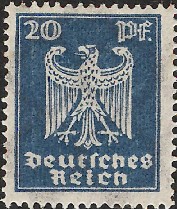
3 p brown 5 p green 10 p red 20 p blue 30 p lilac 40 p olive 50 p orange
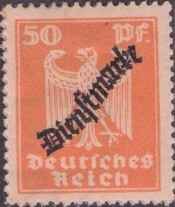
Stamps with overprint 'Dienstmarke' are official
stamps
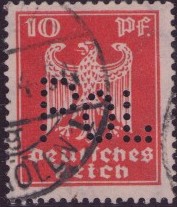
A 10 p stamp with 'Pol' perforation (used by Police)
1 M green ('Rheinstein')
2 M blue (view of Cologne, inscription 'Zwei Mark')
2 M blue (view of Cologne, inscription 'Zwei Reichsmark', 1930)
3 M red ('Marienburg')
5 M green ('Dom zu Speyer')
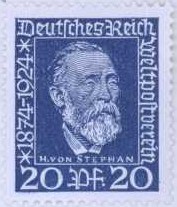
10 p green 20 p blue 60 p brown (with posthorn at bottom) 80 p blue (with posthorn at bottom)
The 60 p was re-issued in 1928 in a slightly lighter tone of brown and on different paper.

Stamps with overprint 'Dienstmarke' are official
stamps
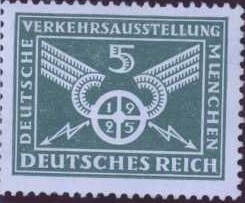
5 p green 10 p red
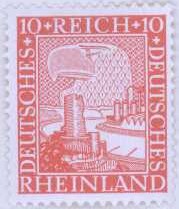
5 p green 10 p red 20 p blue
5 p green (Prussia) 5 p green (Wurttemberg, 1926) 5 p green (Hamburg, 1928) 5 p green (Bremen, 1929) 8 p green (Mecklenburg-Schwerin, 1928) 8 p green (Lippe-Detmold, 1929) 10 p red (Bavaria) 10 p red (Baden, 1926) 15 p red (Oldenburg, 1928) 15 p red (Lubeck, 1929) 20 p blue (Saxony) 25 p blue (Thuringen, 1926) 25 p blue (Brunswick, 1928) 25 p blue (Mecklenburg-Strelitz, 1929) 50 p brown (Hessen, 1926) 50 p brown (Anhalt, 1928) 50 p brown (Schaumburg-Lippe, 1929)
The colour indicated above is the background colour.
Relatively modern forgeries exist of these stamps, examples of such forgeries:

50 p forgeries with 'FAUX' written at the bottom (made by Peter
Winter?). In the above forgeries, an additional forged cancel
'ALBENDORF (BZ BREISGAU) Sommerfrische - Luftkurort' was added.

50 p forgery with 'FAUX' written at the bottom
I've seen a whole sheet of these 50 p 1928 forgeries (20 stamps, 4 rows of 5), with cancel 'FRIEDRICHSHAFEN 6.6.30 19-20 * (Bodensee)'.
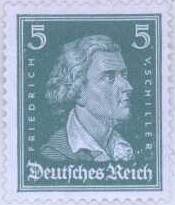
3 p brown (Goethe) 5 p green (Schiller) 8 p green (Beethoven, 1927) 10 p red (Frederic the Great) 15 p orange (Kant) 20 p green (Beethoven) 25 p blue (Goethe) 30 p olive (Lessing) 40 p violet (Leibnitz) 50 p brown (Bach) 80 p brown (Durer) Overprinted 'I.A.A. 10-15.10.1927'

8 p green 15 p orange 25 p blue
'Reprints' of the 3 p brown and 25 p blue exist and were made for the Philatelia '81 exhibition in Frankfurt am Main. They were printed in a minisheet with three stamps; two 3 p stamps and one 25 p stamp in the middle.
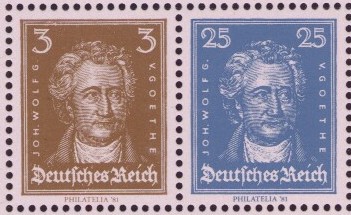
Reprints made for the 'Philatelia '81' exhibition.
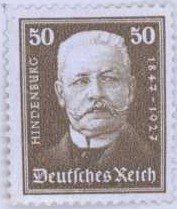
8 p green 15 p red 25 p blue 50 p brown
I have seen the value 8 p printed on top of the value 15 p (from a stamp booklet?).
3 p brown (Ebert) 4 p blue (Hindenburg, 1931) 5 p green (Hindenburg) 6 p olive (Ebert, 1932) 8 p green (Ebert) 10 p orange (Ebert) 10 p lilac (Ebert, 1930) 12 p orange (Hindenburg, 1932) 15 p red (Hindenburg) 20 p blue (Ebert) 20 p grey (Ebert, 1930) 25 p blue (Hindenburg) 30 p green (Ebert) 40 p violet (Hindenburg) 45 p orange (Ebert) 50 p brown (Hindenburg) 60 p brown (Ebert) 80 p yellow (Hindenburg, 1930) 80 p dark brown (Hindenburg) Overprinted '30. Juni 1930' in two lines
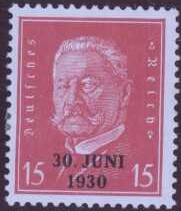
8 p green 15 p red
Ebert was the first president of Germany (1919-1925) and Hindenburg the second (1925-1933). I have seen the values 5 p and 6 p printed together (from stamp booklets which consist of six 6 p stamps and four 5 p stamps; one 6 p and four 5 p stamp on the top row and five 6 p stamps in the bottom row). I'v also seen the values 6 p and 12 p printed together (from a stamp booklet of 12 stamps a top and bottom row of six stamps each, two 6 p stamps in the upper left corner, the rest is 12 p stamps).
8 p green (Aachen) 15 p red (Berlin) 25 p blue (Marienwerder) 50 p brown (Wurzburg)
I have seen a block of 7 stamps, with an additional label with inscription 'Verwende die Wohlfahrts Postkarte!' (use the charity postcard) in green in the upper left part, with three 8 p green in the upper row and four 15 p stamps at the bottom. I've also seen seven 8 p stamps, 4 on top and three at the bottom, with a label with a green cross at the left bottom side.
8 p green (Dresden, Zwinger) 15 p red (Breslau, city hall) 25 p blue (Heidelberg, castle) 50 p brown (Lubeck Holstentor, gate) Surcharged (1932) '6+4Rpf' on 8 p green '12+3Rpf' on 15 p red
I've seen the 15 p stamp with labels with green inscription 'Verwende die Wohl-fahrts-Postkarte!' (use the charity postcards!) below or on top.
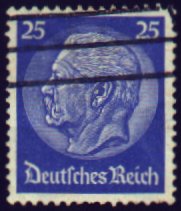
1 p black (1933)
3 p brown (1933)
4 p blue
5 p green
6 p dark green (1933)
8 p orange (1933)
10 p brown (1933)
12 p red
15 p dark red
20 p blue (1933)
25 p blue
30 p olive (1933)
40 p lilac
50 p brown
50 p green and black (1933)
60 p dark red and black (1933)
80 p blue and black (1933)
100 p yellow and black (1933)
With black border mourning stamps
('Trauermarken', 1934 commemorating the death of Hindenburg)

3 p brown and black 5 p green and black 6 p dark green and black 8 p orange and black 12 p red and black 25 p blue and black
These stamps exist attached to labels with
various texts, such as: 'Spare bei der Postsparkasse!',
'Unterstutzt das Deutsche Rote Kreuz', 'Unterstutzt die US
Volkswohlfahrt', 'Trete in die USD ein', 'Alles fur Deutschland'.
Different values also exist printed side by side. These varieties
all come from stamp booklets.
I've also seen tete-beche pairs of the values 1 p and 12 p, 3 p
and 6 p, 4 p and 12 p, 6 p and 8 p; all with the a large space
(the size of two stamps) with vertical coloured lines in between
the individual stamps (see image below for an example).

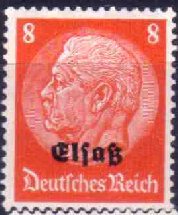
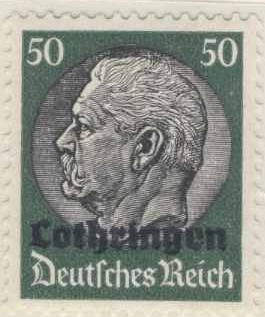
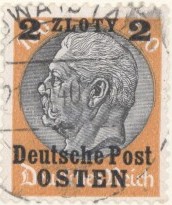
1931 issue; also exists with overprints 'Elsaß' or 'Lothringen'
for use in Alsace and Lorraine, a similar
overprint was used in 'Luxemburg'
during the German occupation of this country. Also the overprint
'Deutsche Post OSTEN' together with a
surcharged in 'Groschen' was used in occupied Poland.
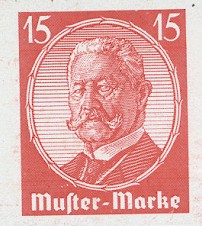
A proof of about 1933, inscription 'Muster - Marke' with the
portrait of Hindenburg
4 p blue (Wartburg) 6 p olive (Stolzenfels) 12 p red (Nurnberg) 25 p blue (Lichtenstein) 40 p lilac (Marburg)
I've seen the 12 p in tete-beche. I've also seen a block of four stamps, two 4 p stamps and two 6 p stamps, 4 p and 6 p printed next to each other with an inverted (tete-beche) 4 p and 6 p pair below it.

Two tete beche of the 12 p value
6 p green 12 p red 25 p blue
I've seen the values 6 p and 12 p in tete-beche. I've also seen the 12 p value with attached labels (both at the bottom and the top of the stamp) with inscription 'fordert auch die Gedenk - Postkarte' in red.
3 p brown (Tannhauser) 4 p blue (Fliegende Hollander) 5 p green (Rheingold) 6 p green (Meistersinger) 8 p orange (Walkure) 12 p red (Siegfried) 20 p blue (Tristan and Isolde) 25 p blue (Lohengrin) 40 p red (Parsifal)
The values 4 p and 6 p exist printed next to each other (also tete-beche). The values 12 p and 8 p also exist printed next to each other (also tete-beche).
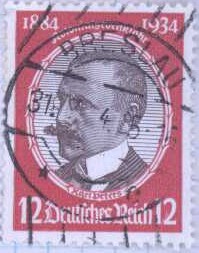
3 p brown and black (Franz A.E. Luderitz) 6 p green and black (Gustav Nachtigal) 12 p red and black (Karl Peters) 25 p blue and black (Hermann von Wissmann)

6 p green 12 p red (different design)
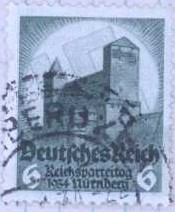
5 p green 12 p red
3 + 2 p brown 4 + 2 p black 5 + 2 p green 6 + 4 p green 8 + 4 p red 12 + 3 p red 20 + 10 p blue 25 + 15 p blue 40 + 35 p llac

6 p green 12 p red

3 p brown 5 p green 12 p red 25 p blue
6 p green 12 p red
6 p green (Schutz) 12 p red (Bach) 25 p blue (Handel)
6 p green 12 p red
3 p brown ('Das Schloss zu Allenstein')
6 p green ('Tannenberg Nationalgedenkmal')
12 p red ('Das Schloss in Konigsberg Pr.')
25 p blue ('Das Schloss zu Hellsberg')
These stamps were sold in minisheets with four stamps (one of each value), with watermark 'OSTROPA' on top and '1935' at the bottom. .
6 p green (first train) 12 p red (steam train) 25 p blue (modern streamlined small train) 40 p lilac (modern streamlined large train)
6 p green 15 p red
6 p green
3 p brown (Ostpreussen) 4 p blue (Schesien) 5 p green (Rheinland) 6 p dark green (Niedersachsen) 8 p orange (Kurmark) 12 p red (Schwarzwald) 15 p brown (Hessen) 25 p blue (Oberbayern) 30 p brown (Friesland) 40 p lilac (Franken)
3 p brown 12 p red
6 + 4 p green (ice skating) 12 + 6 p red (skiing) 25 + 15 p blue (bobsledge)
More of these olympic stamps were issued in 1936.
Click here for stamps of Germany, issued after 1935.